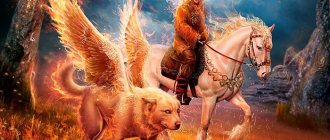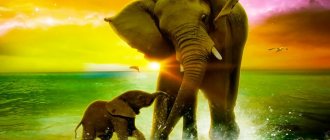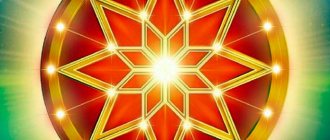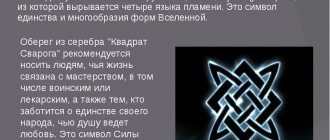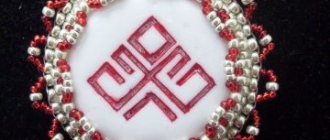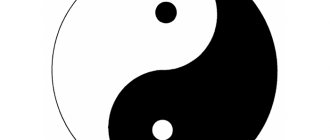History of the origin of the Ouroboros sign
Ourobonos is a coiled snake or dragon biting its own tail.
Although the earliest depiction of Ouroboros in the West was discovered in Egypt, it cannot be said with complete certainty that its homeland was there. The history of the symbol and its use in different cultures began thousands of years ago.
The oldest figures of snakes biting their tails were discovered in China. The earliest of them are dated 4700-2900. BC e. They were found on the chests of buried people.
The first Ouroboros discovered in the West is not so ancient - XIV century. BC. It is made of gold and was found in Egypt. They are united with the Chinese symbol by the goal of connecting the dead and the living and protection, because the first Western serpent is depicted in the tomb of Pharaoh Tutankhamun.
Researchers don't know exactly how closely these symbols are related or where they appeared first. You can trace the influence of Ouroboros on Egyptian culture and the fact that from here it spread throughout Ancient Greece, and then to the Roman Empire and other states that became heirs of its culture.
Semantic messages
Ouroboros tattoo meaning can be as follows:
- In ancient Western countries, people believed that a reptile that curled into a circle represented the endless cycle of life. After death, a creature is reborn, and after creation, it is destroyed.
- The same opinion was shared by the ancient Greek and Aztec peoples who inhabited the South American territory.
- For the ancient Chinese, Oroboro was the prototype of the eastern dragon, which is known in different countries. Oureboros was perceived only positively by them, it made its owner lucky, and provided him with protection from dark forces. Asians also perceived the Ouroboros tattoo as a symbol of cyclicality.
- Among the Hindus, Ouroborus was called the incarnation of the god Shesha, who held the firmament. The creature curled into a ring symbolized the energy remaining in the world after the creation of the Universe. In other words, Hindus equated it with primordial chaos. Among the inhabitants of India, the reptile not only eats its tail, but also wraps itself around the Earth, protecting and guarding it.
- Residents of Scandinavia associated Oroboro with Jörmungand, who lives under water and encircles the earth's surface with his own body. According to Scandinavian legends, the snake constantly increased in size, which is why it could not completely absorb its tail.
Jörmungand for the Scandinavians was an evil creature who wanted to attack the deities during Ragnarok. Here we can also mention cyclicality, since new powerful gods came to replace the deities that fell during Ragnarok.
- The inhabitants of Egypt distinguished themselves with a reverent attitude towards Oroborus. They believed that this creature was extremely powerful, controlling life and death. The Egyptians believed that if Ouroboros stopped patronizing these processes, the whole world would collapse.
Separately, it is necessary to say about the symbolism of Oroboro for the Slavic peoples. Historians believe that this sign came to the ancient Russian lands from Scandinavian or eastern countries.
It is interesting that the Slavs, unlike the inhabitants of Scandinavia, did not attribute negative qualities to the creature. On the contrary, they believed that the snake contained only positive energy and provided protection from evil spirits.
In the Middle Ages, Oroborus was also highly valued. It was endowed with powerful witchcraft properties, which is why it was used by those who practiced alchemy, magic, divination, and healing.
What it looks like: description of the symbol
Most often, a snake biting its tail will form a circle. Less common are images in the form of a figure eight - the sign of infinity, which reinforces the meaning of eternal renewal inherent in the symbol.
Most often, Ouroboros forms a circle.
Ouroboros was carved on wood and stone. Such drawings can be found in magical manuscripts. Sometimes the Ouroboros is surrounded by other symbols that link old and new or end and beginning, such as the first and last letters of the Greek alphabet, “alpha” and “beta.”
Decoding the sign with the mythical serpent
The snake consumes itself in order to gain new life, therefore the general meanings of the symbol are as follows:
- Constant development of the world.
- The cyclical nature of natural processes in the micro- and macrocosm, i.e. man and the Universe: life turns into death, and death gives new life; in nature there is a change of seasons - in winter all living things die, and in summer they are reborn; day turns into night and vice versa.
- No beginning or end.
- The connection of all phenomena, beautiful in their unity.
Meaning among different peoples
In mythology, in which neither the gods nor the world are eternal, Ouroboros symbolizes the constant repetition of the cycle of creation and destruction. Despite the fact that the understanding of this plot in all cultures is similar, different peoples have their own nuances in interpreting the symbol.
Ancient Egypt, Israel and Greece
The first Egyptian image of Ouroboros is in the tomb of the young ruler Tutankhamun, who died in the first half of the 14th century. BC. Its walls are decorated with mythological episodes from the Book of the Dead and Amduat, which describe funeral rituals and the afterlife.
The first image of Ouroboros is in Egypt.
One of the scenes depicts a portrait of a god, whom researchers interpret as a union of opposites in one person: Ra - the god of the Sun and life - and Osiris from the underworld, who symbolized the Moon. The image of a single deity is surrounded by a snake biting its own tail.
Researchers interpret this serpent as an image of another god - Mehen. This is the protector of Ra in the afterlife. The combined symbolism of Mehen, Osiris and Ra coincides with the meaning of Ouroboros.
The image of the serpent also exists in Israel. It signified the power of chaos as well as fertility and healing. In the Tanakh - the Hebrew Bible - the image of a snake appears in different scenes:
- The expulsion of Adam and Eve from Eden (Genesis 3).
- Moses and Aaron demonstrated divine power to Pharaoh by turning their staffs into snakes (Exodus 7).
- Terrible fiery snakes are symbols of evil (“Deuteronomy”, 8:15, “Book of the Prophet Isaiah”) and divine wrath, as well as salvation from it (“Numbers”, 21:4-9), etc.
Another important serpent in Judaism is Leviathan. This is a sea monster that is associated with the image of Satan. The modern meaning of the word "leviathan" is whale.
The Ouroboros symbol came to Greece from Egypt and took on the same meaning as the Phoenix bird - the absence of beginning and end. At first, the snake in this culture signified health. It is present in the image of the vessel of Hygeia, which to this day is a symbol of medicine. The emergence of a positive interpretation of Ouroboros strengthened its ambivalence - its dual character.
Ancient China
For Chinese culture, it is not the snake that is of particular value, but the dragon, which is one of the 4 sacred creatures. It combines constructive and destructive principles, images of earth and sky, snakes and birds.
The Book of Mountains and Seas tells the legend of the dragon Zhulong, who had the face of a man. Spread over the whole world, he himself was the world and its creator. His role is important - he disperses the darkness. The symbolism of Zhulong is constant movement and improvement of oneself and the world, therefore he himself is nature in all its diversity.
The dragon Zhulong was the creator of the world.
The rotation of a snake around the Earth is an important mythological motif. The snake or dragon Ouroboros in this sense is like the waters of the rivers washing the planet.
The peculiarity of the image of Ouroboros in China is the egg in the center of the circle (the most perfect figure), which he forms with his body, wrapped around the Earth. The egg has a connection with the classical Chinese philosophical system - Taoism. Tao is the path of man. Throughout life, people learn their Tao, which leads them to understand the essence of the world and merge with it. This should be the main goal of the living.
Ancient India
The Vedas are ancient Indian wisdom that has been expanded over the centuries. The book tells how to properly perform rituals and sing hymns dedicated to the gods. The Hindu pantheon is striking in its diversity.
Religion absorbed small cults, so all deities have many incarnations. Ananta-shesha - the snake god, who is revered in the south of the country, is an avatar (image) of Vishnu. His other famous incarnations are Krishna and Rama.
According to the legends described in the Puranas (myths), Vishnu is the guardian god of the world. He is part of the triad of Hindu gods, which also includes Brahma, the creator of the world, and Shiva, its destroyer. It appeared in the V-VI centuries. AD
Ananta-shesha is the thousand-headed serpent, the king of all nagas.
The complex Indian chronology is associated with the image of Vishnu. It is cyclical: at the beginning of each divine year, which lasts more than 311 trillion “human” years, Brahma creates the world, and at the end it is destroyed. God himself lives 100 divine years, after which his rebirth will occur.
Ananta-shesha as an image of Vishnu also appears in the Puranas. He is described as a serpent coiled and floating in the waters of the world's oceans. This image also appears in various mythologies. The world is formed from the waters by divine will.
Shesha remains unchanged even when the divine year ends and the world collapses. Being in the heart of Shiva the destroyer, Ananta helps him destroy the material world.
This essence is indicated by the meaning of the parts of his name: “Ananta” - “limitless”, and “Shesha” - “that which remains.”
Germanic-Scandinavian mythology
Jörmungandr is a character from Scandinavian mythology. He was the son of Loki and the giantess Angrboda. The story about him is recorded in the medieval epic collection “Younger Edda”. The god Thor threw Jörmungandr into the ocean, where he grew so large that he could wrap himself around the earth and bite his own tail.
As in the Indian epic, here Jormungandr is important during the death of the world. Ragnarok is the battle of the gods when a serpent emerges from the ocean and poisons Thor. Although he will die, he will have time to cut off Jormungandr’s head. After the death of the gods, the whole world will be destroyed.
The snake eats itself - beliefs of ancient peoples
The sign of Ouroboros was first mentioned in ancient Babylonian chronicles. But the information that has come down from that era does not allow us to accurately indicate its significance for the life of the Babylonians and other peoples of Mesopotamia. Subsequently, already in Ancient Egypt this sign had a clearly defined meaning.
The Egyptians believed that this symbol united all the elements and all worlds, turning out to be a sign of something fundamental for the whole world. As a living being, it was believed that Ouroboros could be the guardian of the underworld and guide both the birth of people and their departure to the next world.
This sign was so important that it was preserved not only in the wall frescoes of the tombs, but even in literary works. He was mentioned in one of the poems written by Pharaoh Pianhi.
From Ancient Egypt, a snake devouring its own tail came to Ancient Greece, where philosophers paid great attention to it. She was often identified with the Phoenix, which rises from the ashes. It was from the image of Ouroboros that the first legends about dragons and the word “dragon” itself arose.
The attitude of the Abrahamic religions to this sign is also extremely interesting. Having arisen separately, against the background of already formed worldviews, they all in their unity reject the sacred meaning of snakes. In the Abrahamic theory, common to both Christianity and Islam with Judaism, snakes are always identified with evil forces.
It was the angel Samael in the form of a snake who was considered the tempter who seduced Adam and Eve from the divine path. At its core, this is one of the few religions in which this sign has an exclusively negative meaning.
This may also be connected with the foundations of the eschatology of Christianity, Islam and Judaism, which clearly rejects the cyclical nature of the world, which is demonstrated by the snake that eats itself.
A snake biting its own tail in different religions
Often the images of mythical gods, spirits and other creatures were transformed, turning into religion, incl. monotheism. Their divine origin faded into the background, but their significance as a symbol remained.
A snake biting its own tail reminds us of the finitude of the material world.
Ouroboros became a reminder in Christianity of the finitude of the material world. This symbolism is based on words from the book of Ecclesiastes. Jewish and Christian traditions recognize the sage Solomon as its author. This book, different from all others in the Bible, describes the cycle of the world, which will definitely come to an end.
Ancient India
In the Vedic religion and Hinduism, Shesha (or Ananta-shesha) appears as one of the forms of God. Images and descriptions of Shesha in the form of a snake biting its own tail are commented on by D. Thorne-Bird, pointing out its connection with the symbol of ouroboros. From ancient times to this day, snakes (nagas) have been revered in India - the patrons of waterways, lakes and springs, as well as the embodiment of life and fertility. In addition, nagas represent the eternal cycle of time and immortality. According to legends, all nagas are the offspring of three snake gods - Vasuki, Takshaka (English) Russian. and Sheshi.
The image of Shesha can often be seen in paintings depicting a coiled snake on which Vishnu sits cross-legged. The coils of Shesha's body symbolize the endless cycle of time. In a broader interpretation of the myth, a huge snake (like a cobra) lives in the world's oceans and has a hundred heads. The space hidden by the massive body of Shesha includes all the planets of the Universe; to be precise, it is Shesha who holds these planets with his many heads and also sings songs of praise in honor of Vishnu. The image of Shesha, among other things, was also used as a protective totem by Indian maharajas, since there was a belief that a snake, encircling the earth with its body, protects it from evil forces. The word “Shesha” itself means “remnant”, which refers to what remains after everything created returns back to primary matter. According to Klaus Klostermeier, the philosophical interpretation of the image of Shesha makes it possible to understand history from the point of view of Hindu philosophy, according to which history is not limited to human history on planet Earth or the history of one single universe: there are countless universes, in each of which certain events are constantly unfolding. events.
Gnosticism and alchemy
Within the framework of Gnosticism, adherents strive to comprehend some secret knowledge (“gnosis”). For this movement, Ouroboros is not the central image. The Greek Gnostics interpreted it in different ways:
- this is a symbol of natural cycles that replace each other, thereby supporting themselves;
- soul of the world;
- unity of contradictory objects;
- life that unites and encloses everything in the world in a cycle.
Ouroboros is a symbol of natural cycles that replace each other.
In Christian Gnosticism, the image of Ouroboros is present in the apocryphal text “Faith Wisdom” (“Pistis Sophia”). Here the resurrected Jesus tells his disciples about the fate of Sophia, an incorporeal being from the upper world, her fall, repentance and salvation.
For alchemy, the image of Ouroboros becomes the personification of self-closure. During alchemical processes, one substance can be transformed into another, becoming more and more perfect with each new experience. So, according to the ideas of alchemists, iron could turn into gold.
The image of Ouroboros changes here: the snake closed in a circle becomes two. One of them was depicted from above and with wings (as a symbol of volatility), and the other from below.
Dragon Ouroboros in psychology
Carl Gustav Jung was a follower of Sigmund Freud. He looked for the origins of human behavior in his subconscious. Jung created the theory of archetypes, according to which there is not only a personal unconscious, but also a collective one, and at its core there are images that evoke the same reactions in everyone.
Ouroboros as an archetype has a similar meaning to a mythological image. This is both self-destruction (eating oneself) and human creative potential. Jung's follower Erich Neumann complemented the archetype, considering it a symbol of the beginning of personality development.
How to decipher Gnostic constructs?
So far we have outlined only the most abstract mythological and symbolic aspects of Gnostic constructions and given a general conceptual definition of ouroboros. Now let us dwell in more detail on the realities that may lie behind these constructions, and on possible approaches to the interpretation of Gnostic ideas. This will allow us to fill our interpretation of Ouroboros with more specific content.
The simplest and most primitive approach is the literal, positivist one. Gnostic fantasies are those ideas with the help of which ancient people tried to comprehend the structure of the Universe. In particular, the above diagram represents a primitive cosmological model, which, when critically examined by the methods of modern science, can easily be discarded as outdated and having no relation to reality. The ancients considered the Earth to be the center of the Universe, surrounded by an ocean in which the “heavenly dragon” Leviathan-Ouroboros splashed. Our ancestors knew only seven planets (including the Moon and the Sun), which is reflected in the diagram, but after Uranus was discovered in the 18th century, and then other planets, not to mention the refutation of the geocentric picture of the world, this model can simply be to be ignored, together with all its fantastic essences, as relating, at best, to the history of human error.
This approach, although convincing, is unsatisfactory, since Gnostic, as well as other religious, ideas are reproduced throughout human history, and therefore cannot be rejected by a simple and straightforward indication of their literal falsification. In the case of Gnostic constructions, we are talking about a whole complex, including physical cosmology as its element. The falsification of this element makes it possible not to take Gnostic cosmology seriously as a literal description of the Universe, but the element is only a part that does not exhaust the whole, which means that other elements of this complex are worth studying.
Of interest to us are those aspects of this approach that are associated with the understanding of the gnostic mood as a direct experience of the most obvious laws of nature at the bodily level - the cycles of birth and inevitable dying, hunger and other physiological needs that cannot be satisfied once and for all. These and other basic laws of human existence were experienced by the Gnostics as the oppression of the Cosmos, whose laws they did not understand and whose negative influence they sought to avoid with the help of their mythological and magical constructions.
From here it is easy to move to the next level of understanding - namely the mythological-magical one. Various characters in Gnostic constructions, in particular the Ophite diagrams, become mythological beings with which the subject deals, for example, after his death. There is a noticeable advantage here over a literal cosmological reading, since a completely different immaterial dimension of life is revealed. After its death, the soul makes a journey, during which a number of meetings await it at each of the tiers of the heavenly hierarchy. Origen gives a description of the spells that had to be cast during the passage of each of the seven ruling demons*.
*Cm. detailed and very convincing analysis of the map of the ascension/descent of the soul in the Ophite diagram: DeConick A. The Road for the Souls Is Through the Planets. P. 55–65.
Most likely, it was this mythological and magical understanding that the Gnostics themselves shared. This point of view, in particular, was held by Hans Jonas, who believed that for the Gnostics “myth is [their] chosen way of reasoning.” At least the first generation of Gnostics literally saw in this model the path of the soul after death, that is, the “objective, spatial journey of the soul,” which encounters real mythological entities and must overcome them by calling their names and casting special magic spells stored in numerous "Books of the Dead". This diagram is a map of the movement of the soul through the celestial spheres.
There is nothing unique in such constructions; the motif of the journey of the soul is quite traditional for ancient beliefs. Franz Cumont describes the standard path of the soul in the ideas of late Antiquity (this description will still be useful to us when considering the next level of interpretation of Gnostic ideas):
“After death she goes back to her heavenly home... Then, as she traverses the zones in heaven, she is stripped of the passions and abilities she acquired during her descent to earth, as if they were garments. She gives her life and nutritional energy to the Moon, to Mercury her greed, to Venus her love desires, to the Sun her intellectual abilities, to Mars her warlike ardor, to Jupiter her ambitious dreams, to Saturn her lazy inclinations. She was naked, freed from all sensuality, the moment she reached the eighth heaven, there to enjoy as a sublime being in the eternal light in which the gods live, blessed without end."
Although the mythological-magical approach is also insufficient, it still offers a much deeper picture in comparison with the first, positivist one. In the words of Walter Wink, the mythological imagination with its symbols is the only way available to man for “sensory perception of the supersensible.” That is why Carl Gustav Jung considered Gnostic constructs as a valuable resource containing authentic psychological experience: through myths a person does not learn something new, but lives in them what is happening in his unconscious, sees on the screen of consciousness a projection of what is unfolding in a completely different, inaccessible for his perception of the plan. However, this is both an advantage of the mythological approach and its weakness, since the effect here is achieved beyond human understanding.
The subject was transformed due to the mysterious living of this mythology, but this transformation did not in any way enrich his understanding of what this mythology corresponds to.
The next, even deeper level of understanding is psychological-ascetic, affecting something extremely close, visual and understandable to anyone. We are talking about the transformation that the subject undergoes in the course of working on himself, in the process of his spiritual and psychological development.
The most famous psychological interpretation of Gnosticism was proposed by Jung and the school of analytical psychology he created. According to this interpretation, archons and other entities are only projections of archetypes of the unconscious, which ancient people, due to their general “non-psychological” nature, took for something that really exists in the outside world. Ancient man, as Jung believed, “...is non-psychological. Mental events occur outside of him in an objective manner. Even those things about which he dreams or dreams seem real to him; this is the only reason why he pays attention to dreams and daydreams.”
What in the Gnostic worldview seemed to be events of a universal scale, in the Jungian interpretation becomes a symbolization of processes occurring in the human psyche. The Divine becomes unconscious, matter and the Demiurge become the human ego, the reunion of the Supreme God with the divine sparks - the “self” or a new synthesis of the conscious ego with the unconscious. In other words, Gnostic metaphysics “is really a psychological immersion.”
The ascetic understanding is similar to the psychological one and can be considered as its reverse side, since it involves conscious efforts to cleanse one’s own soul. The map of posthumous adventures becomes a map of ascetic self-transformation - the authorities of this world, the rulers of the seven planets, symbolize the passions and vices that engulf the human soul. Her ascension becomes a metaphor for purification. The passage of each planet corresponds to the overcoming of one of the seven key passions that torment the human spirit, drawing it into its endlessly repeating cycles. Specific lists of passions and their corresponding planets vary, but in general can be summarized as follows: Moon - gluttony with its orbits of hunger and satiety; Mercury - love of money with its orbits of endless pursuit of more and more profit; Venus is lust with its orbits of excitement and satisfaction; The sun is laziness with its orbits of fruitless dreams; Mars - anger with its orbits of outbreaks and cooling; Jupiter is vanity with its orbits of pursuit of ever greater glory; Saturn is pride with its orbits of exaltation and humiliation.
It is the concept of seven planets, seven demons, seven vices that, apparently, underlies the later Christian concept of the seven or eight deadly sins, which was formed in a monastic-ascetic environment.
The psychological-ascetic interpretation, for all its advantages, still has an obvious drawback: ouroboros are internalized and lose their external social dimension. The cosmos is compressed to the inner world of an individual*.
Historical artifact as a talisman
The Ouroboros symbol was depicted on tombstones in order to connect life and death. Medallions in the shape of a snake eating its tail are found on the bodies of buried people.
Among the Slavs, the snake symbolized infinity. This creature, nicknamed the lizard, guarded the treasures. Therefore, Ouroboros acquired protective properties. Talismans with such an emblem began to be made to protect oneself and family from troubles, illnesses and even black magic.
Necklace
The jewelry is made of silver, gold, precious and semi-precious stones. There are pendants made of unusual materials, such as elk antlers, sperm whale teeth or mammoth ivory.
The neck pendant is made of silver.
Wrist bracelet
The hand of the owner of such jewelry is wrapped in the body of a snake or dragon, the locks are made in the shape of its head and tail. Popular materials for the body are leather and coral stones. The bracelet can also be made in an unusual version - from the vertebrae of a snake.
Sacred amulet
The amulet can look like a simple decoration on the neck or arm. The main thing is the meaning that the owner puts into it. It is believed that such a talisman helps to find inner harmony and self-control. It eliminates fears and develops the best qualities in a person.
A sacred amulet can look like a simple decoration.
Finger ring
The Ouroboros plot in the ring is suitable for both men and women. For the latter, there is a symbolism of wearing jewelry on different fingers:
- large - attracting love and fertility;
- index and nameless - for career success.
Ouroboros and esoterics
The Gnostics were among the first to draw attention to the essence of the symbol and the existential categories personified by it. Some branches of Christianity accepted the philosophy of cyclicity, understanding the deep semantic background of the symbol of the looped serpent. Adherents of Gnosticism considered the sign to personify the eternal confrontation between good and evil, their interdependence and unity. Unfortunately, orthodox Christianity considered such ideas to be a manifestation of heresy, and their supporters were severely punished, until the Renaissance.
The weakening influence of the church during the Renaissance led to the development of science. The culture and beliefs of antiquity began to be actively studied, new views on old truths led to a deeper understanding of symbolism. Alchemists of the Middle Ages saw in Ouroboros the infinity of physical phenomena, including those relating to the state of aggregation of a liquid. Later, a vicious circle in the form of a snake began to symbolize alchemy as a whole. At this time, the sign occurs frequently and can be seen:
- in the works of Helena Blavatsky, the serpent became the main symbol of the Theosophical community she founded;
- the Roerichs - a family known for their occult successes;
- on Tarot cards - the deck contains an image of a looped serpent.
Other movements that study the world of occultism endow the symbol with power, considering it the quintessence of knowledge about the nature of the Universe.
The appearance of Ouroboros in tattoos
The meaning of the tattoo is closely related to what Ouroboros symbolizes in mythology. If a person is close to the worldview projected through this image, i.e. the emergence of the new when the old is destroyed, he can get such a tattoo for himself.
The traditional image of Ouroboros changes at the will of the customer of the drawing or the artist - this will not affect the meaning. Style, black and white or color version, classic rounded image or playing with shape - all this depends only on the author’s imagination.
Modern times
Interest in the symbol in the 20th century. returned after the formation of Jung's theory of archetypes. Another way the image of Ouroboros influences modernity is through neo-Hindu practices that came to the West at the turn of the 19th-20th centuries, incl. Kundalini yoga, which is also based on the image of a snake.
Classical images for certain cultures have formed a single complex of meanings and interpretations of Ouroboros. A person who wears such a pendant or has a tattoo of a snake biting its tail can choose from them what suits him.

